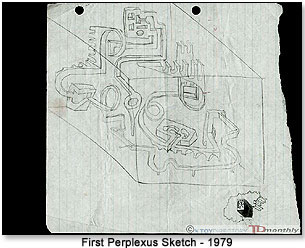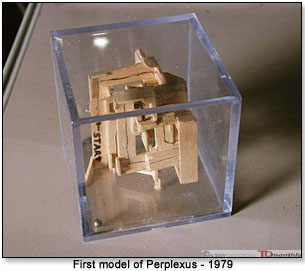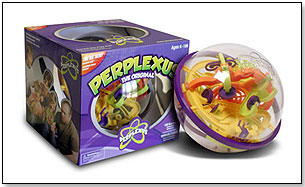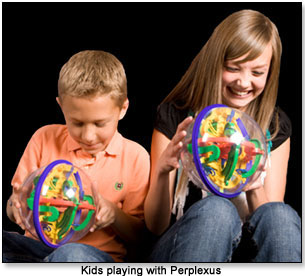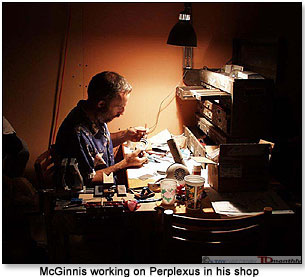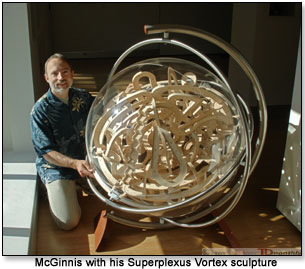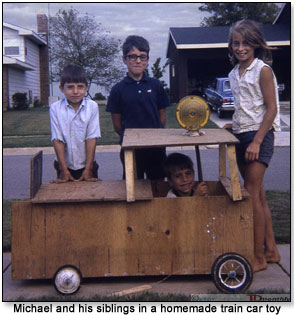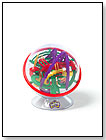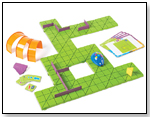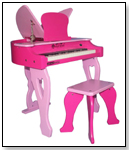|
|
Q & A With Michael McGinnis, Inventor of Perplexus
Q. How did you come up with the idea for your first product? Q. How long did it take to go from the original spark of an idea to actual production? Q. What were the top two or three most significant obstacles you had to overcome to get your product on the market and how did you do it? A. There were some significant obstacles to overcome in getting Perplexus to market. The first was my own fear, and lack of expertise, in creating a viable and attractive design. Also, for many years, I loathed contributing to the plastic culture, as I consider myself an environmentalist. And a third obstacle was my complete lack of business acumen. I am an artist after all, and quite shy. A. There were three distinct reasons why I finally decided to pursue the production of the toy, despite it's relationship to [the culture of] consumption. Firstly, I was (and still am) an adjunct college art instructor raising a family. It was very clear that despite my teaching, doing furniture building and construction on the side, I was not able to keep my family fed without continuously going into debt. Secondly, quite a number of years had past since first conceiving of the concept, yet no one else appeared to reinvent it. I felt it was only a matter of time before they did, so if I was to benefit in any way, I better get going. And thirdly, I felt that the benefits to people who could gain skills, insight, and therapy from interacting with Perplexus justified its pursuit, as long as I really worked to make a lasting, valued product. With royalties we have earned, my wife and I have installed a photovoltaic system that zeros out our [electricity] meter, purchased a hybrid car, and invested in sustainable products. A dream of mine is to be able create an alternative energy utility on a local scale. Q. How much money did you need to create the first prototype and come up with a business plan? A. I am still shocked at how little I spent in creating my first prototype for Perplexus, although that $20 was all I had at the time. I did the making myself, but that model did not compare to what eventually became the first viable hand-made model, Perplexus Original. That model cost around $600; less than $100 for sheet styrene, saw blades, and glue, and another $500 to buy the minimum order of 100 domes made for wedding cake toppers (of which I needed two). I cut those down into hemispheres. Of course, hundreds of hours of physical labor doesn't count in this equation. My original business plan was completely naive, because it consisted of calling toy manufacturers and seeing if they wanted to take on the concept. At the time, I thought that toy companies wanted great ideas from random people, and that their designers would work out all of the physical details. Q. How did you raise it, and how long did it take to raise it? A. The first $20 to make the earliest prototype was saved up from allowances from my parents! Eventually I began to earn a meager living as an art instructor, and did construction projects as well to fund my forays. In my desire to take the Perplexus concept to the next level, I made several attempts to attract investors, to absolutely no positive affect. The first was through ISC, or Invention Submission Corporation, where they took my $1000 and gave me a meaningless analysis of the toy industry with completely generic tables and charts. The second was to go through a friend to hire an investment advisor (a person who made suggestions of who to possibly speak about investing). She sent a man over who had no interest in the game whatsoever, and I could not see him as useful to me anyway. It was my later meeting with Dan Klitsner that literally turned my world around. I was introduced to him by the brother of one of my students. Q. What was the process of finding someone to license Perplexus to like? What were the greatest challenges, and what are the main benefits of forming this sort of partnership? A. Dan agreed to become partners in getting Perplexus to a point that would make it marketable, well designed, and in the hands of a licensee. He, and his team at KID-Interactive were wholly responsible for finding companies to license the product. Before meeting Dan, these tasks were torture to me, nearly debilitating. My experiences with him have been remarkable, and I know this was an incredible stroke of luck that I met him. We first met just before Bop-It was released. Dan worked out each agreement as companies came and went through the evolution of Perplexus. Q. How much involvement do you currently have in the development of the Perplexus line - for instance, what was your involvement with the Perplexus Rookie and the Perplexus Epic? A. In regard to the tangible aspects, I am completely and intimately involved in the creation of the Perplexus line. As my wife can attest, there are many days and nights where I don't get any respite from the demands of creating the line (or making Superplexus commissions and teaching). A shared responsibility Dan and I have is in defining which elements to include in making a commercially viable product. His expertise in the industry gives him insights I don't have. We are both very good at brainstorming, which is a speedy and fun process. I create the actual designs at home over a long period of time, reviewing these with Dan as necessary. We have different and overlapping skill sets. As I have stated, there are times where relying on others is of utmost importance. I implicitly trust and rely on Dan, and we both put our names on the Perplexus patents as co-inventors. Yes, it is my baby, but it takes a village to raise a child. Without Dan, I'd probably make the games too difficult and possibly a little too artsy! Technically, one major process has changed since working on Perplexus Original. At the time it was created, I worked out the design completely by hand, using styrene sheet, cyanoacrylate glue, a jeweler's saw and files, then worked with two CAD designers to draw it up. Finally, Hasbro's engineers tweaked and troubleshooted the design, with lots of late night consultations and tool shots coming my way, to make it production ready. Since then, I have learned CAD myself and designed Rookie and Epic entirely digitally. This is because I was not satisfied with some of the CAD work that resulted in Perplexus Original. My hand-made model had better proportions and playability than the eventual product, but since I had no skills in those areas, I relied on others to draw up the files. Perplexus Original was simple in comparison to Epic, and it was amazing to see how difficult it was for the CAD designers to work out its simpler proportions and relationships. Now I do this myself. Rookie was a piece of cake to design compared to Epic, which tested every bit of my abilities. I struggled constantly with resolving the pathways, forms, interconnections, and spatial relationships. I fought the software, and it often crashed or froze in defiance. I'd get lost as to which part I was working on, or where the ball was supposed to go next. These were all signs that I was on the right track! I wanted a real growth experience and got it. Epic was very complex, yet I had to leave out lots of great ideas because there simply was not enough room for them all. It was important to create a full, space filling (yet open) layout for visibility and sculptural aesthetic. In leading up to manufacturing, I work with James Packer and Matt Nelson, of BusyLife (the manufacturers of Perplexus) as they communicate with the factory to solve various problems. They are passionate about getting things right. My role also includes doing 3D renderings that are used for graphics and public relations, and building the large sculptural models that are seen at events. Dan and I had lots of fun convincing everyone that Epic should be colored white and blue! We really wanted to emphasize its sculptural quality. Q. Many inventors believe they must obtain a patent for their products before marketing it; what advice do you have for them? A. Depending on product longevity and popularity, a patent could be extremely important. One problem, though, is that lots of inventions never actually make it to market, meaning inventors never recover the tremendous cost of patenting them. Further, my original idea for Perplexus was conceptual, and could not be patented until physical models were developed. Jumping into a patent too early could result in insufficient coverage as well as premature revelations of ideas as patents are made public. Before taking that step, an inventor should consult with trusted sources in the industry as to the viability of their idea, do their own patent searches at www.uspto.gov, and eventually find a quality patent attorney. Generally, the more expensive the patent, the better the protection. In my case, the patents are part of the manufacturing agreement. I am the proud owner of three useless patents for mat cutters and a picture framing device. The mat cutters were a great idea, but the patents were weak. They cost about $5k apiece. When questioned about how easily they could be circumvented, the attorney told me that he assumed they were for "vanity," as most patents are. He said that stronger patents cost a lot more because there is more work involved. Lesson learned. Q. What aspect of the toy industry most surprised you when you first started? A. I was shocked that major toy companies had no desire to hear from an individual with a new idea. I really get it now, though, given the sheer number of "inventors" out there. Q. How do you hope your product/s will affect children's lives? A. My original purpose behind Perplexus was to create a tool to help children develop their spatial reasoning and hand-eye skills. I feel that there is little out there to fit the need in the way Perplexus does. It also provides an opportunity to own an aesthetic sculptural object; a piece of art that is visually as well as physically stimulating. Q. If you had to start over, what would you do differently? A. If it was possible to start the process all over again, (which I do not recommend!), I would not waste any time living in fear of both success and failure. Early on, I feared many things, including what may happen if my concept struck it big and I was handed a giant wad of money... What would the meaning of my life be then? Or, what if people simply failed to see the value of my idea? Q. What hardships did you experience during your formative years, and how did those experiences help you persevere with your business pursuits? A. Hardship is a part of every person's life (maybe less so for the 1%'ers). There are many kinds of challenges that transform or shape our interests and abilities. As a kid with so many siblings there was very little opportunity for owning new or popular things. This meant that we had to be creative. We made our own skateboards, scooters, go-carts, forts, rubber band guns, costumes and the like. That definitely gave me confidence to be a maker. I was a terrible reader and writer, being partially blind in my right eye. This was something I didn't realize until well into my adulthood. As a kid, my classroom learning skills were abysmal. I was told I had a lazy eye, and had to wear a patch during third grade. Special reading classes did nothing to improve my plight, since the diagnosis was incorrect. Apparently, the cord around my neck when I was born made me left-handed too. But that was a long time ago. I was socially immature well into college. When I turned 40, my eye doctor discovered the spotty blindness in my eye and informed me that I didn't have normal depth perception. I was incredulous, being a sculptor, and associating my entire life with 3D study. She suggested that my unique ability to think spatially was in response to my inability to see things in the round like most people do. Q. What were the top two or three best pieces of advice you received, and from whom? A. The single best piece of advice I ever received was "now make it!", offered by my instructor in 11th grade. And the second was, "I do not work with others outside of KID, but your idea is unique, and I am willing to direct you towards people in the industry who can help you, or we can become partners, sharing 50/50 in royalties, where we can work together to make the product viable." This was offered by Dan Klitsner. I took the second option. Q. The worst two or three pieces of advice? A. "Just send us a check for $$$, and we will present your idea to trade people at various (undefined) events." -ISC. "You do too much yourself. It's time to have others do parts of it as well." - a former student, referring to making physical objects myself. If I followed that advice, I would never have become so adept at what I do. Q. What one unique quality makes your product better than your competition? A. Perplexus is the world's first 3D labyrinth game. It is a complex, aesthetically pleasing sculptural object that utilizes as much surface area as possible to make efficient, long-lasting, and intricate designs. This provides powerful kinesthetic benefits as well as great play value and visual stimulation. Q. What advice would you give to aspiring toy and game designers and inventors? A. The toughest questions one can ask themselves are, "Is my idea unique and of value? Do I have the drive to keep on going despite the risks, despite the ups and downs? Am I willing to trust others for their expertise, and to reward them accordingly?" If you can answer "yes" to all of these questions, then keep going! If not, there are other things you may wish to do with your life. Q. Where did you grow up? A. My mother and father raised 12 kids. I am number 11, thus nearly the youngest. My father worked for GSA, on the design and construction of federal buildings post offices and courthouses. This meant that there was no spare income, and a good number of moves. I was conceived in Dallas, born north of San Francisco, was a kindergartner in Kansas City, a youth in the Chicago area, and a teen in the San Francisco bay area. I guess it was kind of like navigating through a Perplexus! Q. What is your educational background? A. My formal degree is in sculpture. I first attended the same classroom at Santa Rosa Junior College where I now teach, then received my BA in sculpture at Sonoma State University, and my MFA at the University of Kansas. I began to teach immediately out of graduate school with no break in the educational circuit since kindergarten. Pretty good for someone who flunked my first year of school. Q. What is your favorite toy or game? A. Gee. My favorite game is probably "hide and seek". I don't think we do enough of this anymore! My favorite toy? My wood shop! Q. What's your favorite book? A. Its a toss-up between DANDELION WINE and other short stories by Ray Bradbury (because this gave such a delicious description of childhood summertime in a small Illinois town... memories of my own childhood), THIS PERFECT DAY by Ira Levin (a fascinating look at one possible future, where the earth is a rather pleasant place, at least until you understand what you've been missing), and the entire HARRY POTTER series. Yes, I grew to really care about the characters at Hogwarts, and knew about Snape from the beginning. Unfortunately, reading makes me very sleepy, so sometimes it takes a few months to finish a book. On the other hand, my wife and both kids eat books as snacks, reading whole novels in one afternoon. On a more intellectual level, I seriously love scientific factoid books with lots of cool tidbits in them. Q. Is there anything else you'd like to tell our readers? A. There is no perfect solution to any problem. There is, however, always a better one. Let your ideas evolve and grow. The best way to achieve this is to make as many physical models as you can and to develop your own design/technical skills further. Never stop learning.
 Writer's Bio: Justina Huddleston graduated Magna Cum Laude from Emerson College with a BA in Writing, Literature, and Publishing in 2009. After graduating she was the on-site director of the Boston Children's Museum gift store for a year, selling educational, developmental, and creative activity toys that tied in with the museum's exhibits. Justina also interned at children's book publisher Candlewick Press before moving from Boston to Los Angeles, where she is now Editorial Director of TDmonthly Magazine. Read more articles by this author Writer's Bio: Justina Huddleston graduated Magna Cum Laude from Emerson College with a BA in Writing, Literature, and Publishing in 2009. After graduating she was the on-site director of the Boston Children's Museum gift store for a year, selling educational, developmental, and creative activity toys that tied in with the museum's exhibits. Justina also interned at children's book publisher Candlewick Press before moving from Boston to Los Angeles, where she is now Editorial Director of TDmonthly Magazine. Read more articles by this author |
| |||||||||||||||||||||||||||||||||||||||||||
Disclaimer Privacy Policy Career Opportunities
Use of this site constitutes acceptance of our Terms of Use.
© Copyright 2025 PlayZak®, a division of ToyDirectory.com®, Inc.

